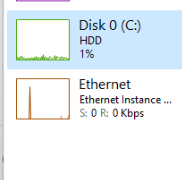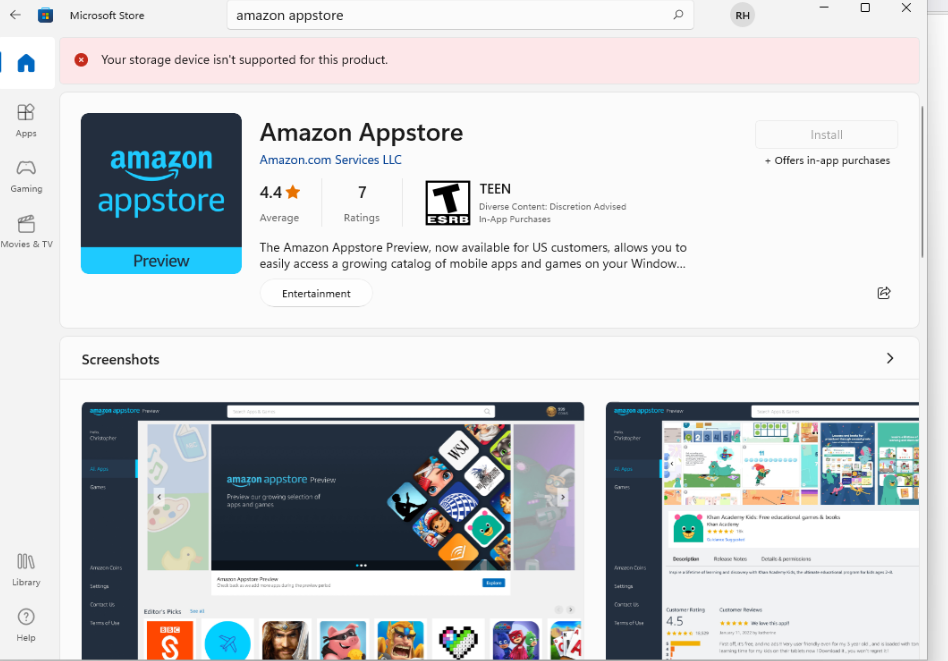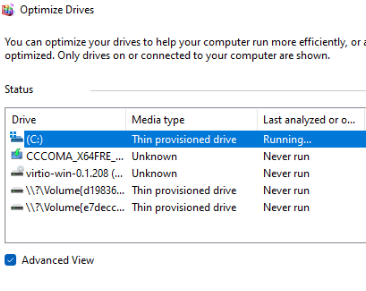-
Posts
58 -
Joined
-
Last visited
Recent Profile Visitors
The recent visitors block is disabled and is not being shown to other users.
runamuk's Achievements
-
-

Windows 11 VM - Possible to have Vdisk to show as SSD ?
runamuk replied to runamuk's topic in VM Engine (KVM)
I tested this for SCSI and SATA and it worked. I was able to get it working by just changing to the appropriate device\volume name. Example below </devices> <qemu:commandline> <qemu:arg value='-set'/> <qemu:arg value='device.scsi0-0-0-2.rotation_rate=1'/> </qemu:commandline> </domain> -

Windows 11 VM - Possible to have Vdisk to show as SSD ?
runamuk replied to runamuk's topic in VM Engine (KVM)
I just tried this. This makes drive into a "thin provisioned drive" but the drive still shows as a HDD under the main system I am still getting the following error. -
I was hoping if anyone knew a possible way to have the Vdisk show as an SSD instead of HDD in Windows. With the recent windows update you can now run Android Apps native; however it required to have an SSD. Even though my Vdisk is stored on my cache drive so runs at SSD speeds it however will show as a HDD under windows due to the VirtIO drivers. Any recommendations would be great.
-
I use OBS and have Zero issues doing this. First find out if Audio Output Capture works at allnot just browser source). If it dose work with Audio Output Capture but not browser source then it sounds like its an issue with the browser. If it still not working in another Browser i suggest making sure Monitor and Output is on and running OBS as Admin.
-
I have fixed this even more and getting way better fps. Add the following just above </features> do not disable hypervisor Once booted into windows open Powershell as admin Enter the following It ask you to reboot
-

Need Help to Setup a Windows 11 VM - GPU Not Passing Error 43
runamuk replied to rakeshyannamani's topic in VM Templates
post the VM xml -

Windows 10 VM not booting when USB controller is passed throught
runamuk replied to PilaScat's topic in VM Templates
This may sound strange but do the following. Make a new VM for Machine select the latest pc-q35 For USB controller select 3.0 Qemu You can select the same data disk after that for your current windows vm so you don't need reinstall. Then push though the controller -

Setup seems very slow - win11 pro on VM (SOLVED)
runamuk replied to SmokeyColes's topic in VM Engine (KVM)
<hostdev mode='subsystem' type='pci' managed='yes'> <driver name='vfio'/> <source> <address domain='0x0000' bus='0x45' slot='0x00' function='0x0'/> </source> <alias name='hostdev0'/> <address type='pci' domain='0x0000' bus='0x06' slot='0x00' function='0x0' multifunction='on'/> </hostdev> <hostdev mode='subsystem' type='pci' managed='yes'> <driver name='vfio'/> <source> <address domain='0x0000' bus='0x45' slot='0x00' function='0x1'/> </source> <alias name='hostdev1'/> <address type='pci' domain='0x0000' bus='0x06' slot='0x00' function='0x1'/> </hostdev> <hostdev mode='subsystem' type='pci' managed='yes'> <driver name='vfio'/> <source> <address domain='0x0000' bus='0x45' slot='0x00' function='0x2'/> </source> <alias name='hostdev2'/> <address type='pci' domain='0x0000' bus='0x06' slot='0x00' function='0x2'/> </hostdev> <hostdev mode='subsystem' type='pci' managed='yes'> <driver name='vfio'/> <source> <address domain='0x0000' bus='0x45' slot='0x00' function='0x3'/> </source> <alias name='hostdev3'/> <address type='pci' domain='0x0000' bus='0x06' slot='0x00' function='0x3'/> </hostdev> <hostdev mode='subsystem' type='usb' managed='no'> I enabled Multifunction for your video card and its usb port. A <hyperv> <relaxed state='on'/> <vapic state='on'/> <spinlocks state='on' retries='8191'/> <vpindex state='on'/> <runtime state='on'/> <synic state='on'/> <stimer state='on'/> <reset state='on'/> <vendor_id state='on' value='pickyourown'/> </hyperv> Add following under hyperv Make sure Drive location is on chach as any action on unraid can slow down your VM. I also recommend checking your pinning page Setting -> Cpu Pinning: pin the first 4 cores to unraid system/apps and the last 4 cores to the vm. -
runamuk changed their profile photo
-
For advanced user such as yourself second baremetal setup as a backup is a viable solution but at that point in time why not run a bare metal system fulltime. It uses such low resources that any old machine can run it smoothly. Personally using PFsense in a VM as my network routing seems high risk. If anything happens to Unraid or the VM, it would completely borked my entire network. If Unraid is your only network solution you could be up a creek without a paddle verry quickly. Simply my concept is don't put all my eggs in one basket; as the last thing I want is be trying to fix my network and whatever happen to my unraid system at the same time.
-
What kind of system are you running. I do have a few lines that can possible help the hyper-V run a little more smooth; try putting the following in under HyperV- Also I highly recommend you are running the latest q35. <hyperv> <relaxed state='on'/> <vapic state='on'/> <spinlocks state='on' retries='8191'/> <vpindex state='on'/> <runtime state='on'/> <synic state='on'/> <stimer state='on'/> <reset state='on'/> <vendor_id state='on' value='putwhatyouwant'/> </hyperv> .
-
I have never even needed a Vbios if setup correctly. Please post a screenshot of your VM page, Also post a screenshot of your IOMMU groups please. (Tools -> System Devices) I see you have not turned on multifunction. I took part of your VM XML and changed it below. I also changed the secondary function to be under the same slot and changed the function. Last I would never recommend having a PFsense VM and Windows VM the same Unraid sever. In fact I wouldn't recommend having PFsense being on your unraid sever at all tbh, but that's just me do what ever makes you happy 😄. <source> <address domain="0x0000" bus="0x02" slot="0x00" function="0x0"/> </source> <rom file="/mnt/user/isos/vbios/gpu_vbios_MSI_1060.rom"/> <address type="pci" domain="0x0000" bus="0x00" slot="0x06" function="0x0" multifunction='on'/> </hostdev> <hostdev mode="subsystem" type="pci" managed="yes"> <driver name="vfio"/> <source> <address domain="0x0000" bus="0x02" slot="0x00" function="0x1"/> </source> <address type="pci" domain="0x0000" bus="0x00" slot="0x06" function="0x1"/> </hostdev> <memballoon model="none"/>
-
I'm sorry to say butt I'm pretty sure that AMD GPU's will not work with the ioapic driver='kvm' ; thus creating the lag. I'm getting around 140 fps with my 2060 super (all on ultra) with an ultra wide monitor. Windows 11 VM 10 dedicated cores from a 5950 16 gig ram 2060 Super I know there is another workaround with AMD gpu but it is not easy.







